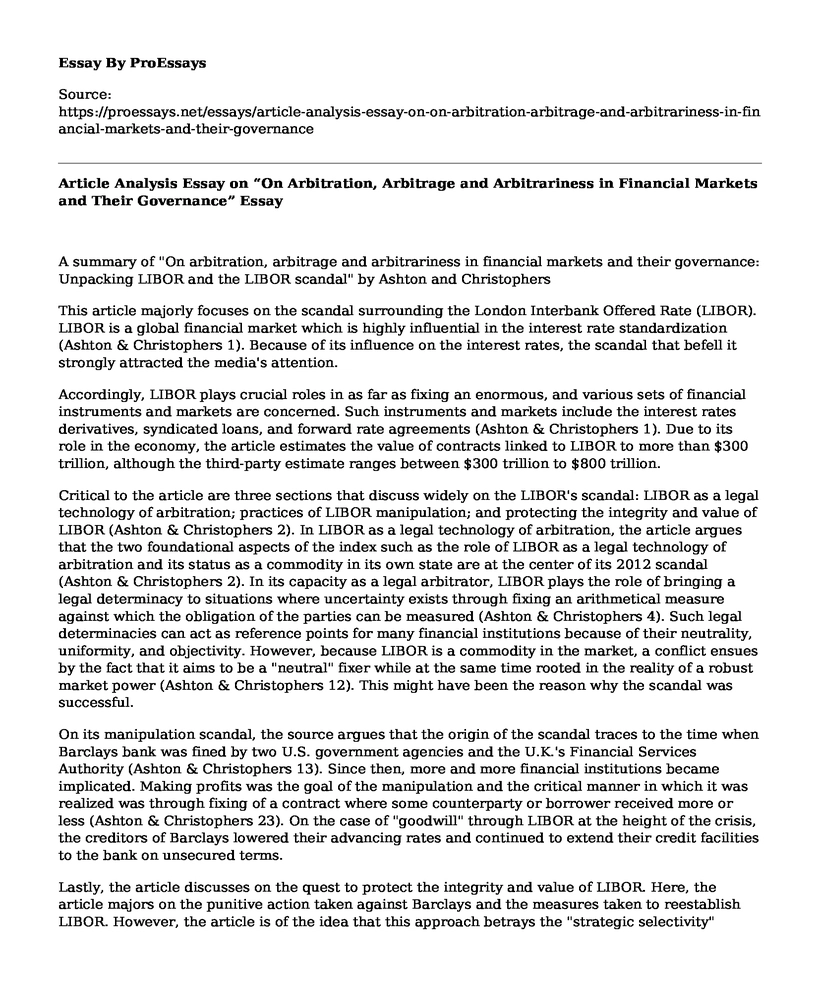A summary of "On arbitration, arbitrage and arbitrariness in financial markets and their governance: Unpacking LIBOR and the LIBOR scandal" by Ashton and Christophers
This article majorly focuses on the scandal surrounding the London Interbank Offered Rate (LIBOR). LIBOR is a global financial market which is highly influential in the interest rate standardization (Ashton & Christophers 1). Because of its influence on the interest rates, the scandal that befell it strongly attracted the media's attention.
Accordingly, LIBOR plays crucial roles in as far as fixing an enormous, and various sets of financial instruments and markets are concerned. Such instruments and markets include the interest rates derivatives, syndicated loans, and forward rate agreements (Ashton & Christophers 1). Due to its role in the economy, the article estimates the value of contracts linked to LIBOR to more than $300 trillion, although the third-party estimate ranges between $300 trillion to $800 trillion.
Critical to the article are three sections that discuss widely on the LIBOR's scandal: LIBOR as a legal technology of arbitration; practices of LIBOR manipulation; and protecting the integrity and value of LIBOR (Ashton & Christophers 2). In LIBOR as a legal technology of arbitration, the article argues that the two foundational aspects of the index such as the role of LIBOR as a legal technology of arbitration and its status as a commodity in its own state are at the center of its 2012 scandal (Ashton & Christophers 2). In its capacity as a legal arbitrator, LIBOR plays the role of bringing a legal determinacy to situations where uncertainty exists through fixing an arithmetical measure against which the obligation of the parties can be measured (Ashton & Christophers 4). Such legal determinacies can act as reference points for many financial institutions because of their neutrality, uniformity, and objectivity. However, because LIBOR is a commodity in the market, a conflict ensues by the fact that it aims to be a "neutral" fixer while at the same time rooted in the reality of a robust market power (Ashton & Christophers 12). This might have been the reason why the scandal was successful.
On its manipulation scandal, the source argues that the origin of the scandal traces to the time when Barclays bank was fined by two U.S. government agencies and the U.K.'s Financial Services Authority (Ashton & Christophers 13). Since then, more and more financial institutions became implicated. Making profits was the goal of the manipulation and the critical manner in which it was realized was through fixing of a contract where some counterparty or borrower received more or less (Ashton & Christophers 23). On the case of "goodwill" through LIBOR at the height of the crisis, the creditors of Barclays lowered their advancing rates and continued to extend their credit facilities to the bank on unsecured terms.
Lastly, the article discusses on the quest to protect the integrity and value of LIBOR. Here, the article majors on the punitive action taken against Barclays and the measures taken to reestablish LIBOR. However, the article is of the idea that this approach betrays the "strategic selectivity" because it is precisely in favor of protecting the integrity and value of LIBOR.
Discussion Questions
James W. Messerschmidt and Piers Beirne cite conflict theory as one of the known theories of crime. Assuming this theory is correct, then it means a lot must be done to reduce crime including eliminating or reducing class inequality. What kind of policy changes can be implemented to minimize class inequality?
Considering the role played by the media in the criminal justice system, explain whether the media is more useful as a cure for crime or more damaging as a cause of crime.
In part three of "Criminology" by Messerschmidt and Beirne, white-collar crimes are listed as part of the contemporary types of crime. How well can the law enforcers ensure effective investigation of computer-related crimes in relation to the jurisdictional issues?
The classical theory of crime places heavy reliance on the concept of free will. How can this concept be demonstrated empirically?
According to research, the males are more prevalent to criminal activities than females. What are some of the reasons, in particular, bring this difference?
Works Cited
Ashton, Philip, and Brett Christophers. "On arbitration, arbitrage and arbitrariness in financial markets and their governance: Unpacking LIBOR and the LIBOR scandal." Economy and Society44.2 (2015).
Messerschmidt, James, and Piers Beirne. Criminology: A Sociological Approach. 6th ed., Oxford University Press, 2014.
Cite this page
Article Analysis Essay on "On Arbitration, Arbitrage and Arbitrariness in Financial Markets and Their Governance". (2022, Nov 11). Retrieved from https://proessays.net/essays/article-analysis-essay-on-on-arbitration-arbitrage-and-arbitrariness-in-financial-markets-and-their-governance
If you are the original author of this essay and no longer wish to have it published on the ProEssays website, please click below to request its removal:
- Determinants of Market Interest Rates Case Study
- Banking Retail Product Development or Customer Satisfaction, Effect of Management Decision
- Independent Audit Report of Biocon Pharma Company Limited
- Should We Use Credit Cards? - Research Paper
- Funding Sports/Festivals: Economic Impact and Misapplication - Research Paper
- The Consumption-Wealth Effect: Stock Market, Interest Rates, Inflation & More - Essay Sample
- Audit Program: Selecting IT Infrastructure Controls - Report Example







